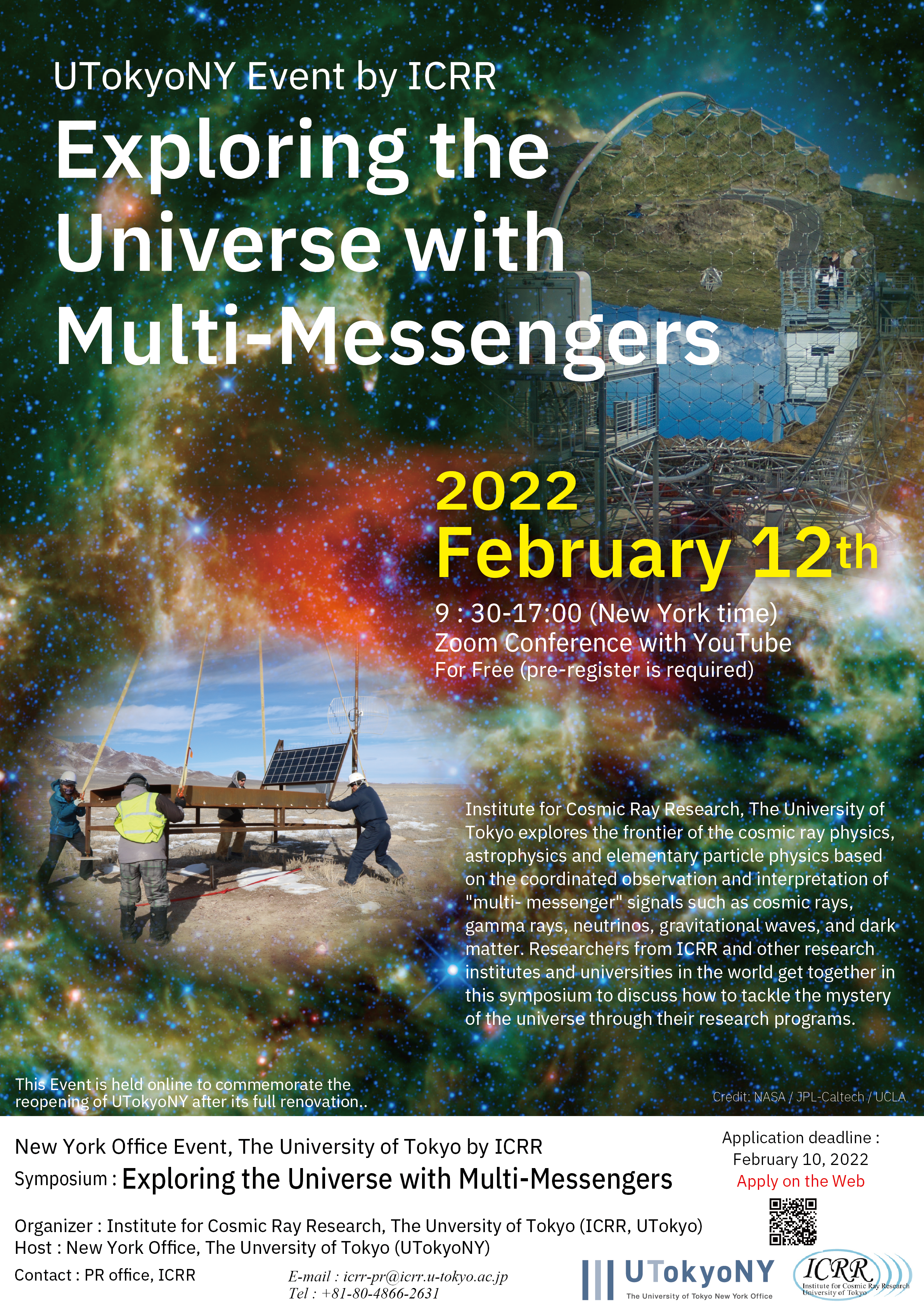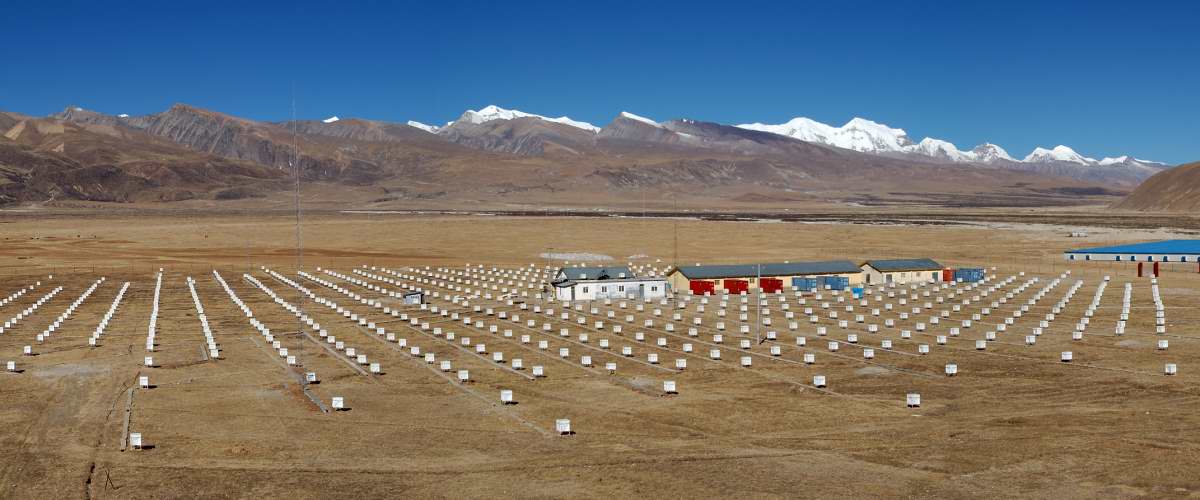Overview
Institute for Cosmic Ray Research, The University of Tokyo explores the frontier of the cosmic ray physics, astrophysics and elementary particle physics based on the coordinated observation and interpretation of "multi- messenger" signals such as cosmic rays, gamma rays, neutrinos, gravitational waves, and dark matter. Researchers from ICRR and other research institutes and universities in the world get together in this symposium to discuss how to tackle the mystery of the universe through their research programs.
This symposium will be held online via ZOOM with live streaming on YouTube. To participate, please choose either platform, ZOOM Conference or YouTube, in the application form. The URL (with participation certificate) to access the event will be sent to the participants two days before the event.

| Date | February 12, 2022 Sat. 9:30am-5:00pm (New York Time) |
|---|---|
| Place | Zoom and YouTube |
| Entry Fee | Free |
| Capacity | No restrictions |
| How to Apply | Link for Application |
| Deadline | February 10, 2022 Thursday. |
| Sponsored | Institute for Cosmic Ray Research, The University of Tokyo |
| Link | Get your flyer from here |
This event is held online to commemorate the reopening of UTokyoNY after its full renovation. The speakers will present from Japan and the USA.
You can find what UTokyoNY events are and other UTokyoNY events at the following page.

Introducing the speakers
Masaharu Masuyama
President of UTokyoNY
President of UTokyoNY
Masaharu Masuyama has been the president of UTokyoNY since it was established in 2015. He graduated from the University of Tokyo’s Faculty of Engineering in 1968 and joined an international trading company based in Tokyo. He worked as a sales engineer for the company and was transferred twice to New York and stationed in New York for nearly 15 years in total. After the second assignment, he left the company and established his own consulting firm in the US in 1994 and continues working in New York area ever since. He will introduce UTokyoNY at the beginning of the symposium.
David N. Spergel
President of Simons Foundation
President of Simons Foundation
David N. Spergel is a theoretical astrophysicist with research Interests ranging from the search for planets around nearby stars to the shape of the universe. After his long career including as a Professor at Princeton University, leadership roles in astronomical project including the Roman Space Telescope, WMAP, and the Atacama Cosmology Telescope and Kavll IPMU PI, he founded the Center for Computational Astrophysics at the Flatiron Institute. As of July 2021, he is President of the Simons Foundation. He will address the symposium as a guest at the beginning of the symposium.
Takaaki Kajita
Director of Institute for Cosmic Ray Research, UTokyo
Director of Institute for Cosmic Ray Research, UTokyo
Takaaki Kajita is also the Special University Professor, UTokyo. He joined experiments at Kamiokande and Super-Kamiokande at the Kamioka Observatory in central Japan and shared the 2015 Nobel Prize in Physics for his role in discovering atmospheric neutrino oscillations. Currently, he is the project leader of KAGRA. He will make a keynote presentation on “Multi-messenger astronomy and ICRR” at the Keynote speech.
Masahiro Teshima
Professor of Institute for Cosmic Ray Research, UTokyo
Professor of Institute for Cosmic Ray Research, UTokyo
Masahiro Teshima is also Director, Professor at Max-Planck-Institute for Physics, Germany. He specializes in high energy gamma ray astronomy, cosmic ray physics and astroparticle physics and serves as PI of LST which is the part of CTA being under construction in LaPalma, Canary Islands, Spain. LST-1, prototype of LST was inaugurated in October 2018 and selected "21st Century Technology Awards 2019" and "European Technology Awards 2021".
Reshmi Mukherjee
Helen Goodhart Altschul Professor of Barnard College, Columbia University
Helen Goodhart Altschul Professor of Barnard College, Columbia University
Reshmi Mukherjee is also the Vice Provost of Academic Centers and Research at Barnard College. Her research interests are in high-energy astrophysics and astroparticle physics. She uses ground-based atmospheric Cherenkov telescopes at the VERITAS Observatory located in southern Arizona to study galactic and extragalactic high-energy gamma-ray sources. Her area of expertise is active galaxies, thought to be powered by supermassive black holes at their centers. She was formerly Spokesperson of VERITAS. She is currently also a member of CTA.
Hiroyuki Sagawa
Vice Director, Professor of Institute for Cosmic Ray Research, UTokyo
Vice Director, Professor of Institute for Cosmic Ray Research, UTokyo
Hiroyuki Sagawa devotes himself to lead and was the former co-spokesperson of the Telescope Array(TA) experiment in Utah for searching origins of ultra-high energy cosmic rays around 1020eV (Former co-spokesperson), and is involved in the construction of TAx4 which quadruple the TA effective area. The project team obtained evidence for a cluster of events (hotspot) in the direction of Ursa Major.
Glennys Farrar
Silver Professor and Collegiate Professor of Physics at New York University
Silver Professor and Collegiate Professor of Physics at New York University
Glennys Farrar specializes in particle physics, cosmology and the study of dark matter. She earned her PhD from Princeton in 1971, becoming the first woman to receive a physics PhD from Princeton University. At NYU, she chaired the physics department and founded the Center for Cosmology and Particle Physics. She is a recent Chair of the American Physical Society's Division of Astrophysics, and a member of the Snowmass Steering Group. She is also a member of Auger which detects ultra-high energy cosmic rays in the southern hemisphere and expected to tell us her perspective on uncovering the origins of UHECRs with TA, Auger and IceCube.
Masato Takita
Professor of Institute for Cosmic Ray Research, UTokyo
Professor of Institute for Cosmic Ray Research, UTokyo
Masato Takita is PI of Tibet ASγ experiment which aims to observe high energy cosmic rays at Yangbajing in Tibet, China. After installation of underground muon detectors, 100 TeV gamma rays were successfully detected. He was awarded 67th Nishina Memorial Prize in 2021 for “establishment of the sub-PeV gamma ray astronomy and elucidation of the origin of galactic cosmic rays”.
Peter K. Fritschel
Principal Investigator of MIT Kavli Institute for Astrophysics and Space Research
Principal Investigator of MIT Kavli Institute for Astrophysics and Space Research
Peter K. Fritschel is currently Chief Detector Scientist for LIGO - the Laser Interferometric Gravitational-wave Observatory. His research has focused on the design and development of ground-based gravitational-wave detectors, using extraordinarily sensitive, multi-kilometer baseline interferometers. He is a recipient of the 2016 Special Breakthrough Prize in Fundamental Physics awarded to the LIGO Collaboration and the 2022 Richard A. Isaacson Award in Gravitational-Wave Science.
Peter Shawhan
Professor at University of Maryland
Professor at University of Maryland
Peter Shawhan is a Professor at University of Maryland, Department of Physics. His primary research for the past 20 years has been direct detection of gravitational waves with the LIGO and Virgo detectors, and he has held numerous leadership positions within the LIGO Scientific Collaboration. He was instrumental in establishing and nurturing a program of sharing prompt information about gravitational-wave event candidates with astronomers to allow them to look for corresponding signals in their instruments. That groundwork enabled a remarkably rich campaign of astronomical follow-up observations and study, spanning the whole electromagnetic spectrum, when LIGO and Virgo detected the first binary neutron merger event, in August 2017. As a LIGO contributor, he is a recipient of the 2016 Special Breakthrough Prize in Fundamental Physics awarded to the LIGO Collaboration. He is now serving as President of the IAU Commission on Gravitational Wave Astrophysics. He has been named a University of Maryland Distinguished Scholar-Teacher since 2021.
Hideyuki Tagoshi
Professor of Institute for Cosmic Ray Research, UTokyo
Professor of Institute for Cosmic Ray Research, UTokyo
Hideyuki Tagoshi 's research interests include astrophysics and general relativity with a focus on gravitational waves. He is participating in LIGO-Virgo-KAGRA international collaboration as a leader of the data analysis team of KAGRA. He aims to detect gravitational wave signals by analyzing the data taken by KAGRA together with LIGO-Virgo data, and to contribute to the further development of gravitational wave astronomy.
What kind of projects will be focused?

Cherenkov Telescope Array (CTA)
During the past few years, Very High Energy (VHE) gamma ray astronomy has made spectacular progress and has established itself as a vital branch of astrophysics. To advance this field even further, Cherenkov Telescope Array (CTA), the next generation VHE gamma ray observatory, was proposed in the framework of a worldwide, international collaboration.

Telescope Array Experiment (TA)
The Telescope Array (TA) was built in Utah, USA to study the origin and nature of Ultra-High Energy Cosmic Rays (UHECRs). The project has been operated by the international collaboration of researchers from Japan, USA, Korea, Russia, Belgium and Czechia. In 2019, construction of the TA extension (TAx4), which will quadruple the TA effective area started.

Tibet ASγ Experiment
In collaboration with China, an air shower observation array was built at Yangbajing in Tibet, China to observe high-energy cosmic rays. Underground muon detectors added to the site worked successfully in detecting gamma rays over 100 TeV which revealed the existence of yet-unknown cosmic ray accelerator (PeVatron) in our galaxy.

Gravitational Wave Telescope, KAGRA
The Large-scale Cryogenic Gravitational wave Telescope, KAGRA, was completed in 2019 and started gravitational wave observation in February 2020. KAGRA is collaborating with GW detection projects, such as advanced-LIGO (USA), advance-VIRGO (Italy-France-Netherland), GEO (UK-Germany) to explore the gravitational wave astronomy and multi-messenger astronomy with other astronomical observation channels.
Contact
Contact Information
Tel : mail to icrr-pr@icrr.u-tokyo.ac.jp
map : How to access
Web : Institute for Cosmic Ray Research, The University of Tokyo






